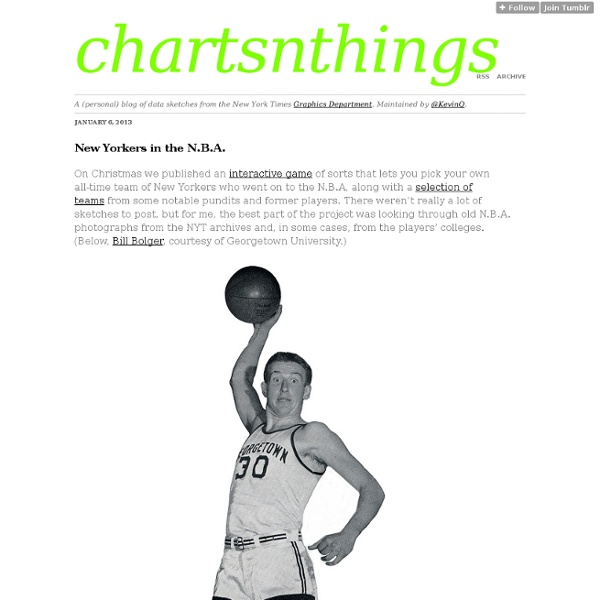Chartsnthings
19 Sketches of Quarterback Timelines On Sunday Eli Manning started his 150th consecutive game for the Giants, the highest active streak in the NFL and the third-longest streak in NFL history. (One of the other two people above him is his brother, Peyton.) The graphics department published an interactive graphic that put Eli’s streak in the context of about 2,000 streaks from about 500 pro quarterbacks. The graphic lets you explore the qbs and search for any quarterback or explore a team to go down memory lane for your team. It’s not particularly important news, but the data provided by pro-football-reference is incredibly detailed and the concept lended itself to a variety of sketches. A couple bar charts in R. And percent of games started (the people are 100% are players like Andrew Luck or RGIII who just haven’t played a lot of seasons.) Ported to a browser, just using total starts: And share of total possible starts …or all the way back to 1970
Infographics news
Matthew Ericson – ericson.net
The winners of the 34th Edition of the Best of News Design contest were released today, so I’ve updated my interactive crosstab of SND winners that lets you see at a glance which publications won awards in which categories. One particularly interesting thing to me: There were only 19 awards give in the information graphics categories — 17 for individual works and 2 for portfolios. That’s down from 97 just three years ago. I’d be curious to know how much of the decline comes from fewer print graphics being produced in general in newspapers — and probably also fewer entries in the contest — and how much is from a different, and much tougher, set of judges than in past years. Just pushed out an update to the Adobe Illustrator MultiExporter script that lets you specify if you want to export PNGs and JPGs at a different scale factor so that you can generate versions of the images at double resolution for iPhone retina displays. I’ve posted the slides from my presentation as a PDF.
The Daily Viz | By Matt Stiles
Zoom : 50 classiques de la « dataviz »
La data visualization -- l'art d'organiser les données sous forme graphique -- se pratique de plus en plus souvent sur Internet: c'est là qu'on l'apprivoise facilement, grâce aux nombreux outils permettant de construire une infographie en quelques clics, là aussi qu'on exploite le mieux son potentiel interactif, et là encore qu'elle circule le plus vite, grâce aux réseaux de blogueurs passionnés de graphisme. Mais la semaine dernière, c'est un lieu bien physique qui a mis la «dataviz» à l'honneur. Sept jours durant, l'agence numérique La Fonderie a investi le pittoresque campus des Cordeliers , à Paris, pour y exposer en grand format une cinquantaine d'infographies parmi les plus marquantes de ces dernières années. Toutes ou presque restent visibles sur le site de l'«Expoviz» ... « Sous la peau », qui illustre les différents systèmes du corps humain, les vins de France selon leur origine géographique et les routes américaines en lignes de métro .
Related:
Related:



